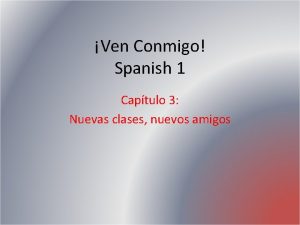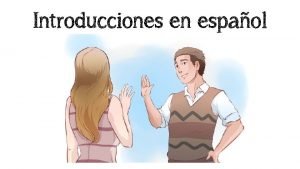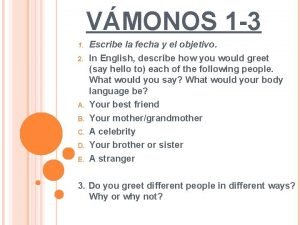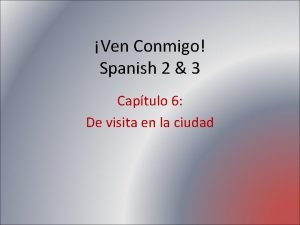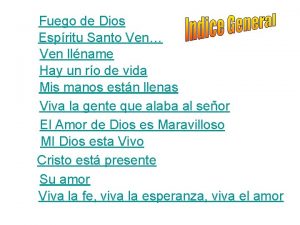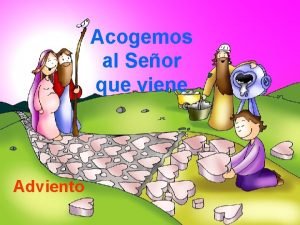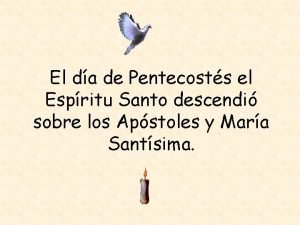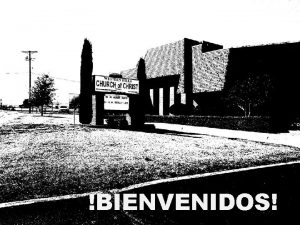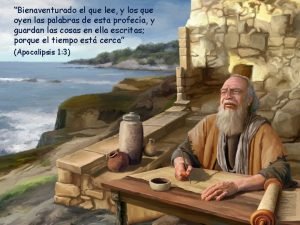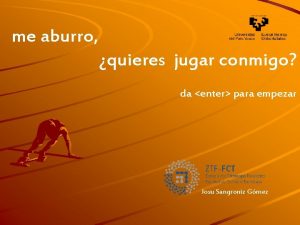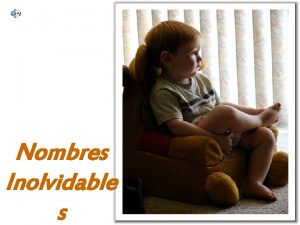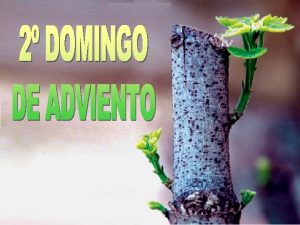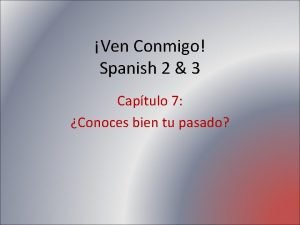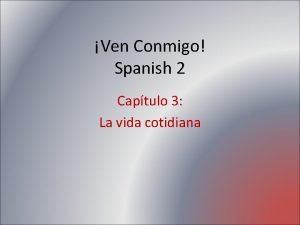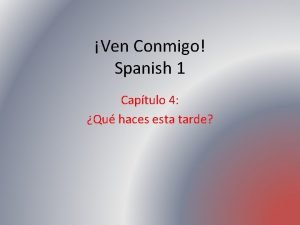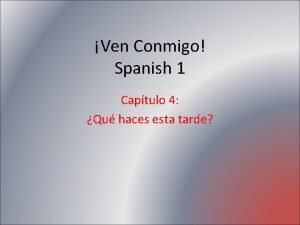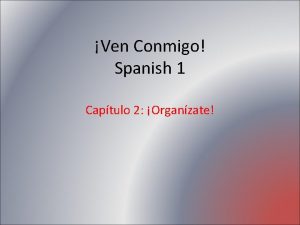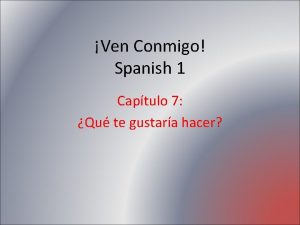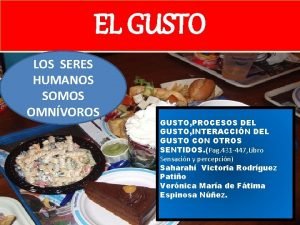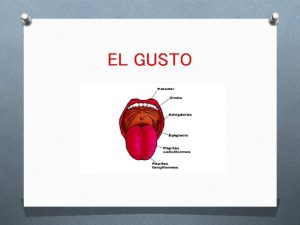Ven Conmigo Spanish 1 Capitulo 1 Mucho gusto



















- Slides: 19

¡Ven Conmigo! Spanish 1 Capitulo 1: ¡Mucho gusto!

Saying hello ¡Hola! Buenos días. Buenas tardes. (12: 00 P. M. – 6: 00 P. M. ) Buenas noches. (7: 00 P. M. )

Saying goodbye Adios. Goodbye. Bueno, tengo clase. Well, I have class. Chao. ‘Bye. Hasta luego. See you later. Hasta mañana. See you tomorrow. Tengo que irme. I have to go.

Nota Cultural ØSpanish speakers often greet each other with a handshake or a kiss. ØIn Spain, friends may greet each other with a light kiss on both cheeks. ØLatin Americans kiss on only one cheek. ØWhen men greet each other, they often shake hands, pat each other on the back, or hug. ØYoung people often shake hands when they meet or say goodbye. ØFamily members usually greet each other with a kiss.

Introductions Me llamo … My name is … Este es mi amigo… This is my (male) friend… Soy… I am … Esta es mi amiga… This is my (female) friend… ¿Y tú? ¿Cómo te llamas? And you? What’s your name? Se llama… His/her name is… ¡Mucho gusto! Nice to meet you! Encantado/a Delighted to meet you. Igualmente. Same here.

Asking how someone is To ask: To respond: ¿Como estás? How are you? Regular. Estoy (bastante) bien, Okay. gracias. I’m (pretty) well, thanks. Mas o menos. So-so. Yo también. Me too. (Muy) mal. (Very) bad. Estupendo/a. Great. ¡Horrible! Excelente. Great. Excellent. ¿Y tú? And you? ¿Qué tal? How’s it going?

Asking how someone is Continued… Throughout Spain and Latin America: ¿Qué pasa? What’s happening? ¿Qué hay? What’s up? México: ¿Qué hubo? ¿Qué onda? What’s up?

Subject pronouns tú and yo § Use the pronoun yo to refer to yourself. § In Spanish, yo (I) is not capitalized, except at the beginning of a sentence. § Use tú (you) when you’re talking to another student, a friend, or to someone who is about your own age. Notice that tú has an accent. PRACTICE: tú and yo Which pronoun is implied but not stated in each sentence? 1. ¿Cómo te llamas? 2. Me llamo Mercedes Margarita. 3. Soy Francisco. 4. ¿Cómo estás, Francisco? 5. Estoy bien, gracias.

Nota Cultural Interpersonal Distance To discuss: 1. You’re sitting on a crowded bus. When one more passenger gets on, you should… a) move over and make room for the newcomer, even if it means rubbing shoulders with the person next to you. b) keep your place and avoid touching your neighbor. 2. You’re standing on the street corner talking to a close friend. Your friend will probably expect you to stand… a) about an arm’s length away. b) close enough to allow your friend to touch you without reaching.

Nota Cultural To comprehend: 1. a. Buses are often crowded, and people expect to squeeze together. This may take some getting used to! 2. b. Generally, Spanish speakers stand sit closer to one another than most people in the United States do. Your Spanish-speaking friend might think you’re a little bit unfriendly if you stand too far away.

Cultura: España (norte) Video

Asking and saying how old someone is To ask: ¿Cuántos años tienes? How old are you? ¿Cuántos años tiene? How old is (he/she)? To answer: Tengo … años. I’m … years old. Tiene … años. (He/she) is … years old.

Asking where someone is from and saying where you’re from To ask: To answer: ¿De dónde eres? Where are you from? Soy de los Estados Unidos. I’m from the United States. ¿De dónde es…? Where is … from? Es de… (She/He) is from… When talking about where someone is from, forms of ser are always used. The words soy, eres, and es are all forms of the verb ser, which is one way to say to be in Spanish.

Forming questions with question words 1. So far you’ve learned to ask questions using several different words. ¿Cómo estás? How are you? ¿Cómo te llamas? What’s your name? ¿Cuántos años tienes? How old are you? ¿De dónde eres? Where are you from? These question words have accents. 2. Notice that ¿cómo? can mean how? or what? depending on context.

Talking about likes and dislikes To ask: To answer: ¿Qué te gusta? What do you like? Me gusta la comida mexicana. I like Mexican food. ¿Te gusta…? Do you like…? Me gusta mucho el tenis. I like tennis a lot. ¿Te gusta el fútbol? Do you like soccer? No me gusta la natación. I don’t like swimming. Sí, pero me gusta más el béisbol. Yes, but I like baseball more.

Vocabulario: Los deportes Sports el baloncesto el fútbol el béisbol el fútbol norteamericano la natación el tenis el voleibol

Vocabulario: La comida Food la cafetería el chocolate la comida mexicana (italiana, china…) la ensalada la(s) fruta(s) la pizza

Vocabulario: La música y las clases La música 1. el jazz 2. la música clásica 3. la música pop 4. la música rock 5. la música de… Las clases 1. el español 2. la clase de inglés 3. la tarea

Nouns and definite articles 1. Nouns are words used to name people, places, things and ideas. 2. All the nouns in the vocabulary have definite articles el or la (the) before them. 3. Generally el is used before masculine nouns and la before feminine nouns. 4. When learning new nouns, always learn the definite article that goes with the noun at the same time.
 Nice to meet you mucho gusto
Nice to meet you mucho gusto Nice to meet you mucho gusto
Nice to meet you mucho gusto Ven conmigo spanish 1
Ven conmigo spanish 1 De nada. encantado. adiós. hasta la vista. mucho gusto.
De nada. encantado. adiós. hasta la vista. mucho gusto. Mucho gusto
Mucho gusto Mucho gusto, rosabel.
Mucho gusto, rosabel. What does ven conmigo mean
What does ven conmigo mean Espiritu santo ven en el nombre del señor
Espiritu santo ven en el nombre del señor Gure aita zeruetan zarana
Gure aita zeruetan zarana No apagues el fuego del espíritu santo
No apagues el fuego del espíritu santo Portal ve hepatik venöz sistem patenttir
Portal ve hepatik venöz sistem patenttir Ven oh prodigo ven sin tardar te llama dios
Ven oh prodigo ven sin tardar te llama dios Ven di sal haz ten ve pon se meanings
Ven di sal haz ten ve pon se meanings Poema amapola
Poema amapola Rosario del sagrado corazón de jesús escrito
Rosario del sagrado corazón de jesús escrito Todos mis amigos estudian conmigo
Todos mis amigos estudian conmigo Bienaventurado el que leen y oyen las palabras
Bienaventurado el que leen y oyen las palabras Te atreves a jugar conmigo
Te atreves a jugar conmigo Necesito encontrarme conmigo misma
Necesito encontrarme conmigo misma El universo esta conmigo
El universo esta conmigo


